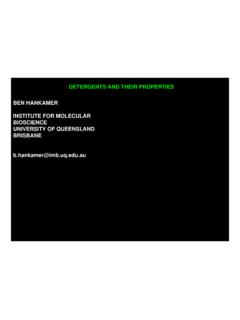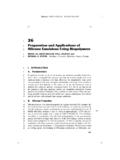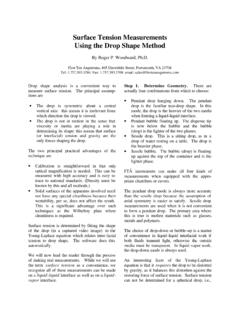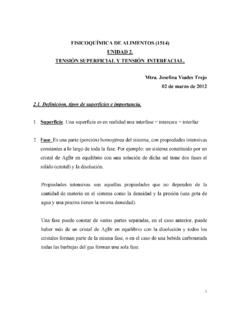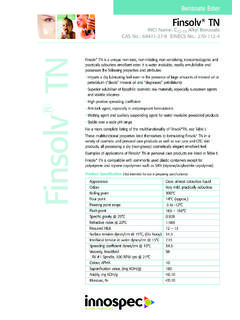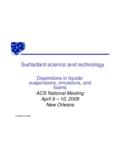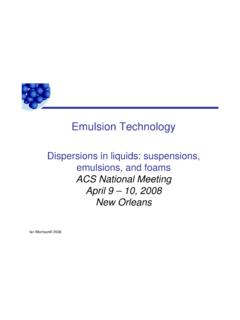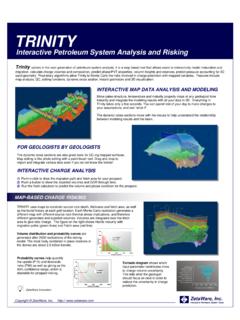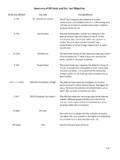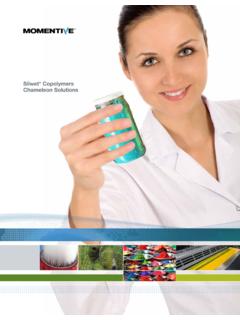Transcription of Emulsions
1 Emulsions BY. Dr. Jarupa Viyoch Dept. of Pharmaceutical Technology (2106). Scope Definition Composition Type of Emulsions Determination Test Selection of ingredients emulsion consistency emulsion theory Emulsifying agent Preparation HLB system Stability Emulsions heterogenous systems of one liquid dispersed throughout another in the form of droplets usually exceeding micrometre in diameter Compositions Internal/Discontinuous/Dispersed phase External/Continuous phase Emulsifying agent Forms Liquids Semisolids emulsion Types 1. oil-in-water (o/w). 2. water-in-oil (w/o). 3. water-in-oil-in-water (w/o/w). 4. oil-in-water-in-oil (o/w/o). Determination of emulsion Types By phase ratio between oil and water phase By order of addition slowly add oil into water o/w By type of emulsifier phase that the emulsifier is soluble will most probably be continuous phase Tests for Identification of emulsion Types Dilution test: emulsion can be diluted only with external phase Dye test: CoCl2/filter paper test: filter paper impregnated with CoCl2 and dried (blue) changes to pink when o/w emulsion is added Fluorescence: oils fluoresce under UV light Conductivity: for ionic o/w Emulsions o/w Emulsions conduct electric current Choice of emulsion Types Fats or oils for oral administration.
2 - o/w is formed to mask unpleasant taste For administration: - o/w - w/o For external application: - o/w for water soluble drugs easily wash from skin non greasy texture - w/o occlusive effect influence the absorption of drugs cleansing skin moisturizing creams (designed to prevent moisture loss from skin). Choice of Oil Phase The type of oil affect on: - viscosity - spread - film forming - the transport of drug into skin liquid paraffin (hard, soft and light liquid paraffin), silicone, beeswax, fatty alcohol and so on emulsion Consistency Texture or feel of a product - viscosity Rheological properties of emulsion can be controlled by: 1. Volume concentration of dispersed phase: if increase viscosity of product increase if above about 60% phase inversion 2.
3 Particle size of disperse phase: decrease size increase viscosity small globule increase flocculation polydispersed system lower viscosity 3. Viscosity of continuous phase 4. Nature and concentration of emulsifying system Purpose of Emulsions Oral formulation 1. Enhancing bioavailability 2. Giving controlled rate of drug release 3. Affording protection to oxidation or hydrolysis Topical formulation 1. Easily applied and can be formulated to eliminate oiliness and staining 2. Carrying water which is an excellent softener to skin emulsion Theory To explain how emulsifying agents act in promoting emulsification and in maintaining the stability of the resulting emulsion - Surface tension theory (important in initial formation).
4 The force causing each liquid to resist breaking up into smaller particle is called interfacial tension . Surfactants promote the lowering of this resistance - Surface orientation theory Emulsifying agent having a greater hydrophilic character than hydrophobic character will promote an o/w emulsion - Plastic or interfacial film theory emulsifying agent surrounding the droplets of the internal phase as a thin layer of film adsorbed on the surface of the droplets, prevent the contact and coalescing of the internal phase - Rate of coalescence theory - Phase volume theory Film Monomolecular film Multimolecular film Solid particle film Water oil Solid ? E = ? 2?o/w (1- cos ?). ? E = the energy to expel an absorbed particle from the interface into the phase that it is predominant wet ?
5 = its contact angle between solid and water phase water oil oil solid 90 <90 >90. interface s/w< ?s/o s/w> ?s/o most stable o/w w/o Mechanism To form droplets - surface free energy or surface tension - system at its lowest free energy is thermodynamically stable - Emulsions are not thermodynamically stable To stabilize droplets (by surfactants or polymers). - by reducing the interfacial tension - by packing of the emulsifier molecules Microemulsions The droplet size is below micrometer Transparent Form spontaneously during preparation Thermodynamically stable (no change spontaneously, and if forced to change, it will return to the stable state). Emulsifying agents must be present at the interface to prevent coalescence of the internal phase: 1.
6 To reduce the interfacial tension 2. To be interfacial barrier (most influence on emulsion stability). - increase viscosity of continuous phase - energy barrier the electric double layer -+- - +. +- - + +. +- -+- + +. the steric repulsion from absorbed polymer tail loop train Compositions Emulsifying agents, Emulsifiers, Emulgents, Surfactants - primary - auxiliary The other formulation additives 1. Preservatives: MP:PP 10:1. 2. Antioxidants: BHT, BHA etc. 3. Humectants: propylene glycol, glycerol, sorbitol Fact of Emulsifying Agents Structure polar group hydrocarbon Reside at interface When the concentration is increased in excess of CMC (the critical micellization concentration), micelles is formed Properties 1.
7 Compatible with the other ingredients 2. Not interfere with the stability or efficacy of the therapeutic agent 3. Stable and not deteriorate in the preparation 4. Nontoxic 5. Little odor, taste or color 6. Promote emulsification and to maintain the stability Emulsifier Classification According to ionic composed of an organic lipophilic group (surface active portion). Synthetic and semisynthetic surfactants - Anionic - Cationic - Nonionic - Amphoteric Naturally occurring materials and their derivativrs Anionic Surfactants Soaps Fatty acid + Base Soaps - o/w Emulsions - in acidic condition precipitated FFA. - external use - combination of soap (TEA stearate) with an oil-soluble auxiliary emulsifier (cetyl alcohol) o/w mixed emulsifer - incompatible with polyvalent cations Anionic Surfactants (cont.)
8 - Soap of di/trivalent metal Cal oleate w/o Emulsions - Amine soaps: N(CH2CH2OH)3. neutral pH. incompatible with acids and high concentration of electrolytes Sulfated and sulfonated compound: - SLS. stable over high pH range o/w Emulsions Sulfated and sulfonated compound (cont.). - SLS. fairly resistant to divalent metal ions used in combination with a nonionic oil-soluble emulsifying agent or fatty alcohol to produce a good Emulsions - sodium dioctylsulfosuccinate used as wetting agent Cationic surfactants Quaternary ammonium compounds: Cetyl trimethylammonium bromide (Cetrimide) CH3(CH2)15N+(CH3)3Br- Used with nonionic, oil-soluble auxiliary emulsifiers Toxicity and irritancy Incompatible with anionic surfactants, polyvalent anions and unstable at high pH.
9 Nonionic surfactants Low toxicity and irritancy oral, parenteral High degree of compatibility Less sensitive to change pH or to addition of electrolytes Most of them are based on: 1. Hydrophobic part: FA or alcohol (C12-18). 2. Hydrophilic part: alcohol (-OH) and/or ethylene oxide (-OCH2CH2). Nonionic surfactants (cont.). Glycol and glycerol esters - Glyceryl monostearate (a polyhydric alcohol FA ester): strongly hydrophobic material produce w/o Emulsions - Self-emulsifying glycerol monostearate soap + glyceryl monooleate diethylene glycol monostearate propylene glycol monooleate Nonionic surfactants (cont.). Sorbitan esters - the esterification of 1 or more of the hydroxyl groups of sorbitan with either lauric, oleic, palmitic or steraic acid - tend to form w/o - used with polysorbates to produce o/w or w/o Nonionic surfactants (cont.)
10 Polysorbates (Tween). - polyethylene glycol derivatives of the sorbitan ester - variation in water solubility based on: type of FA. the number of oxyethylene gr. in the polyethylene glycol chains - compatible with most anionic, cationic and nonionic materials Polysorbates (cont.). - provide neutral pH and stable to the effects of heat, pH change and high conc. of electrolytes - low toxicity - unpleasant taste - form complex with preservatives Fatty alcohol polyglycol ethers - condensation products of polyethylene glycol and fatty alcohols: polyethylene glycol monocetyl ether (Cetomacrogol 1000). - high water solubility - stable over a wide pH range - salted out by high conc.

